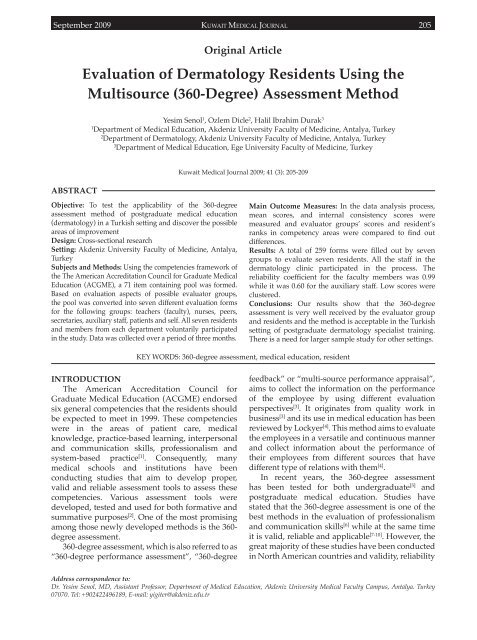Vol 41 # 3 September 2009 - Kma.org.kw
Vol 41 # 3 September 2009 - Kma.org.kw
Vol 41 # 3 September 2009 - Kma.org.kw
You also want an ePaper? Increase the reach of your titles
YUMPU automatically turns print PDFs into web optimized ePapers that Google loves.
<strong>September</strong> <strong>2009</strong><br />
KUWAIT MEDICAL JOURNAL 205<br />
Original Article<br />
Evaluation of Dermatology Residents Using the<br />
Multisource (360-Degree) Assessment Method<br />
Yesim Senol 1 , Ozlem Dicle 2 , Halil Ibrahim Durak 3<br />
1<br />
Department of Medical Education, Akdeniz University Faculty of Medicine, Antalya, Turkey<br />
2<br />
Department of Dermatology, Akdeniz University Faculty of Medicine, Antalya, Turkey<br />
3<br />
Department of Medical Education, Ege University Faculty of Medicine, Turkey<br />
ABSTRACT<br />
Kuwait Medical Journal <strong>2009</strong>; <strong>41</strong> (3): 205-209<br />
Objective: To test the applicability of the 360-degree<br />
assessment method of postgraduate medical education<br />
(dermatology) in a Turkish setting and discover the possible<br />
areas of improvement<br />
Design: Cross-sectional research<br />
Setting: Akdeniz University Faculty of Medicine, Antalya,<br />
Turkey<br />
Subjects and Methods: Using the competencies framework of<br />
the The American Accreditation Council for Graduate Medical<br />
Education (ACGME), a 71 item containing pool was formed.<br />
Based on evaluation aspects of possible evaluator groups,<br />
the pool was converted into seven different evaluation forms<br />
for the following groups: teachers (faculty), nurses, peers,<br />
secretaries, auxiliary staff, patients and self. All seven residents<br />
and members from each department voluntarily participated<br />
in the study. Data was collected over a period of three months.<br />
Main Outcome Measures: In the data analysis process,<br />
mean scores, and internal consistency scores were<br />
measured and evaluator groups’ scores and resident’s<br />
ranks in competency areas were compared to find out<br />
differences.<br />
Results: A total of 259 forms were filled out by seven<br />
groups to evaluate seven residents. All the staff in the<br />
dermatology clinic participated in the process. The<br />
reliability coefficient for the faculty members was 0.99<br />
while it was 0.60 for the auxiliary staff. Low scores were<br />
clustered.<br />
Conclusions: Our results show that the 360-degree<br />
assessment is very well received by the evaluator group<br />
and residents and the method is acceptable in the Turkish<br />
setting of postgraduate dermatology specialist training.<br />
There is a need for larger sample study for other settings.<br />
KEY WORDS: 360-degree assessment, medical education, resident<br />
INTRODUCTION<br />
The American Accreditation Council for<br />
Graduate Medical Education (ACGME) endorsed<br />
six general competencies that the residents should<br />
be expected to meet in 1999. These competencies<br />
were in the areas of patient care, medical<br />
knowledge, practice-based learning, interpersonal<br />
and communication skills, professionalism and<br />
system-based practice [1] . Consequently, many<br />
medical schools and institutions have been<br />
conducting studies that aim to develop proper,<br />
valid and reliable assessment tools to assess these<br />
competencies. Various assessment tools were<br />
developed, tested and used for both formative and<br />
summative purposes [2] . One of the most promising<br />
among those newly developed methods is the 360-<br />
degree assessment.<br />
360-degree assessment, which is also referred to as<br />
“360-degree performance assessment”, “360-degree<br />
feedback” or “multi-source performance appraisal”,<br />
aims to collect the information on the performance<br />
of the employee by using different evaluation<br />
perspectives [3] . It originates from quality work in<br />
business [3] and its use in medical education has been<br />
reviewed by Lockyer [4] . This method aims to evaluate<br />
the employees in a versatile and continuous manner<br />
and collect information about the performance of<br />
their employees from different sources that have<br />
different type of relations with them [4] .<br />
In recent years, the 360-degree assessment<br />
has been tested for both undergraduate [5] and<br />
postgraduate medical education. Studies have<br />
stated that the 360-degree assessment is one of the<br />
best methods in the evaluation of professionalism<br />
and communication skills [6] while at the same time<br />
it is valid, reliable and applicable [7-10] . However, the<br />
great majority of these studies have been conducted<br />
in North American countries and validity, reliability<br />
Address correspondence to:<br />
Dr. Yesim Senol, MD, Assistant Professor, Department of Medical Education, Akdeniz University Medical Faculty Campus, Antalya. Turkey<br />
07070. Tel: +902422496189, E-mail: yigiter@akdeniz.edu.tr
















